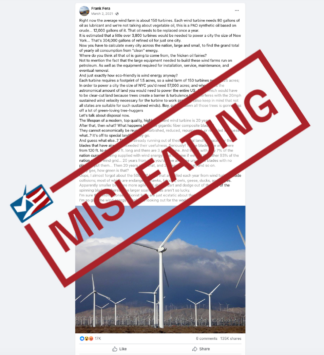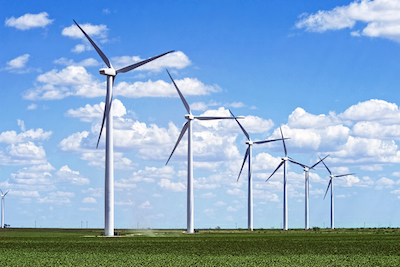Q: Are wind farms harmful to the environment?
A: Like all energy sources, wind farms have some negative environmental impacts. But getting energy from wind farms results in dramatically lower greenhouse gas emissions than getting it from fossil fuels.
FULL QUESTION
I received this post on Facebook today. I know it contains a lot of claims [challenging the eco-friendliness of wind turbines] and I don’t know where to start in terms of validating them (for myself). Can you help out?
FULL ANSWER
A genre of lengthy posts on social media claims to poke holes in measures designed to reduce greenhouse gas emissions and mitigate climate change. The posts throw out numerous statistics without citations, making it difficult to quickly sort fact from fiction.

A reader recently contacted us asking for help evaluating one such post, which cast doubt on the eco-friendliness of wind energy. The post has been circulating on Facebook since March 2021, racking up more than 135,000 shares. Other versions of the post have also been spreading on social media.
Some statistics and statements in the post are arguably accurate, while others are misleading or flat-out wrong. But perhaps more important is what the post left out. It referenced the petroleum products used while building, operating, maintaining and decommissioning wind turbines without ever stating that over its entire life cycle, a wind turbine produces among the lowest greenhouse gas emissions of the main electricity sources in the U.S.

The post also misleadingly said that the land for wind farms “would have to be clear-cut land” and referenced the need to cut down “all those trees.” But in the U.S., wind farms are largely located on land that is already not forested, and this is likely to remain the case as wind energy expands.
The post discussed the landfill space needed for decommissioned wind turbine blades without providing the context that, even as wind power increases, they will make up a small percentage of all waste, and without mentioning efforts to recycle them. And it referenced bird deaths from wind farms without putting them in the context of far greater threats to birds, such as collisions with glass buildings and vehicles.
We consulted experts on wind energy to get to the bottom of the claims made in the post, and to provide context on the challenges associated with this source of renewable energy.
Wind Turbines Generate Low Emissions Over Their Lifetimes
The major advantage of wind turbines is that, taking into account their entire lifespan, they generate very low emissions compared with fossil fuels.
Researchers often calculate greenhouse gas emissions associated with methods of electricity generation using a technique called life cycle assessment. In the case of wind energy, this includes emissions generated in the course of “extraction and processing of materials, fabrication of components, transportation, installation, operations and maintenance … decommissioning, and disposal or recycling,” Aubryn Cooperman, an engineering analyst at the National Renewable Energy Laboratory, told us via email.
“Each of these processes may have emissions associated with the equipment used, such as trucks, cranes, ships, etc.,” she said. “Petroleum-based fuels are used for most types of transportation and portable equipment, and the related emissions are accounted for in the wind energy lifecycle assessment.”
In the case of fossil fuels, a life cycle assessment of greenhouse gas emissions also includes emissions caused by burning the fuel, such as coal or natural gas.
A report from NREL reviewed studies of life cycle greenhouse gas emissions for various sources of electricity. The median published estimates of emissions associated with wind were more than 37 times lower than those from natural gas and 77 times lower than those from coal.
Over their lifetimes, wind farms also are associated with very little generation of air pollutants such as particulate matter and ground-level ozone.
Despite this, the Facebook post misleadingly implied that because petroleum products can be used in various ways in building, operating, maintaining and removing wind turbines, this means that they do not qualify as clean energy.
First, the post presented various statistics on the lubricant oil in wind turbines, used in varying amounts depending on the turbine. To be clear, this oil is used to lubricate the moving parts in wind turbines and is distinct from fuels such as gasoline that are combusted and produce greenhouse gas emissions.
“Now you have to calculate every city across the nation, large and small, to find the grand total of yearly oil consumption from ‘clean’ energy,” the post said. “Where do you think all that oil is going to come from, the fricken oil fairies?”
The post went on to describe the use of petroleum products by “the large equipment needed to build these wind farms,” as well as service, maintain and remove them.
As we’ve said, emissions from petroleum product-powered equipment associated with wind farms are included in life cycle emissions calculations, and these indicate that wind farms are far cleaner sources of energy than fossil fuels.
“It’s also worth noting that as the transportation sector decarbonizes, that will reduce emissions in the wind energy lifecycle as well,” Cooperman said.
As for the lubricant oil used in wind turbines, this oil does need to be changed from time to time, which can be challenging given the locations and height of the turbines. However, it does not necessarily need to be changed annually, contrary to what the post said.
“Oil change interval on wind turbines has been extended over the years and nowadays, it is typical to do every 5 or 7 years,” Shawn Sheng, a senior research engineer at NREL, told us in an email. “Some research is being done by extending this even further to ten years or longer, such as fill-for-life (~20 years) oil.”
Emissions associated with changing this oil are included in life cycle emissions calculations, Cooperman said.
Many machines require lubricant oil, and the wind industry makes up only a fraction of the market for these products. Furthermore, lubricants only make up 1% of petroleum products produced in U.S. refineries.
Post Distorts Wind Farm Land Use Impacts
Next, the Facebook post listed various statistics about wind farm land use, mixing somewhat plausible figures with estimates based on bad math and misleading statements about impacts on forests.
“And just exactly how eco-friendly is wind energy anyway?” the post said. “Each turbine requires a footprint of 1.5 acres, so a wind farm of 150 turbines needs 225 acres…” This estimate is roughly plausible if considering the direct footprint of a relatively new, average-sized land-based wind turbine, but it doesn’t acknowledge the wide variation in turbine size.
Grace Wu, who studies land use and climate change mitigation at UC Santa Barbara, told us via email that the science and engineering community would not calculate the space requirements of a wind farm per turbine, but rather per unit of energy the wind farm can produce.
“The larger the wind turbine the more spacing it required, so to generalize across wind turbines itself (treating the unit as the wind turbine) is inaccurate,” she said. Wind turbines can have one megawatt of capacity to over 10 megawatts of capacity, Wu explained. Offshore wind turbines can be greater than 20 megawatts.
A May 2024 U.S. Department of Agriculture report on utility-scale solar and wind installations in rural areas said that the typical direct footprint of a wind farm is approximately 0.74 acres per megawatt of capacity. The direct footprint of a wind farm includes “the relatively small area on which service roads, turbine pads, and other infrastructure are constructed,” the report said.
Wind turbine capacity has been increasing. The average land-based wind turbine installed in 2022 can generate 3.2 megawatts of electricity, according to a report from the U.S. Department of Energy. Based on this, the average land-based turbine installed in 2022 would have a direct footprint of more than two acres.
Wind farms also have an indirect footprint, the USDA report explained, since wind turbines need sufficient spacing between them to best take advantage of wind flow. However, the land between wind turbines often can still be used for other purposes — typically for growing crops or as rangeland.

The post’s math and logic went more seriously awry as it discussed the broader impacts of wind farm land use. “In order to power a city the size of NYC you’d need 57,000 acres; and who knows the astronomical amount of land you would need to power the entire US,” the post said.
Here, the post did its own internal math incorrectly. The post previously had claimed it would take 3,800 turbines to power a city the size of New York, and 3,800 multiplied by the post’s estimated footprint of 1.5 acres per turbine is 5,700 acres, not 57,000 acres.
A spokesperson from the U.S. Energy Information Administration told us via email that it “would be impossible” to accurately calculate the number of turbines needed to power a city without knowing various other factors, including the height of the turbines, wind speed and generation capacity.
The USDA report found that in 2020, there were 88,000 acres in rural areas of the U.S. in the direct footprint of wind farms. As of 2023, 10% of U.S. electricity came from wind farms, according to the EIA. For context, the U.S. has 897 million acres of farmland.
The post’s suggestion that the entire U.S. would be solely powered by wind farms is unrealistic. According to EIA projections for 2050, even in a high-uptake scenario a minority of electricity in the U.S. would be generated by wind, with solar power showing a greater increase. “There is no scenario we have modeled in which there would be only one source of electricity generation in the United States,” the EIA spokesperson told us.
The post also did not put the land use requirements of wind farms in the context of land use requirements of other methods of generating electricity. A 2022 study published in PLOS One indicated that, when looking just at the direct footprint, natural gas and coal use more land per unit of energy generated than wind.
However, “the answer differs significantly depending on whether or not one considers spacing between turbines,” Wu said. Wind is more space-intensive than most other energy sources when taking into account the full area of wind farms.
The Facebook post misleadingly said that the land used by wind farms would all need to be clear cut. “Boy, cutting down all those trees is gonna piss off a lot of green-loving tree-huggers,” the post said.
Building wind farms does sometimes require trees to be cut down. But Wu explained that in the U.S., wind farms are largely located on existing agricultural land in the Midwest. “There are of course *some* cases of wind farms in forest land, but the vast majority of wind capacity has and will be sited in the ‘wind belt’ (midwest),” she said.
According to the USDA report, between 2012 and 2020 just around 3% of newly built wind farms were located on forest land.
Wind Turbine Blades Represent Small Proportion of All Waste
The Facebook post also painted a misleading picture of what happens to wind turbine blades at the end of their life.
“They cannot economically be reused, refurbished, reduced, repurposed, or recycled so guess what..? It’s off to special landfills they go,” the post said. “And guess what else..? They’re already running out of these special landfill spaces for the blades that have already exceeded their usefulness.”
Claire Barlow, a sustainability and materials engineer at the University of Cambridge, explained to us in an email that there are real challenges associated with the end of life of wind turbine blades. She said that the “normal lifetime” of a wind turbine is 20 to 25 years, and that the blades currently being decommissioned generally come from a time when wind energy was “starting to take off in a big way” — particularly in Europe and China. This means that “the number of end-of-life blades coming through will increase hugely in the next decade, and steadily after that.”
Putting them in landfills is the cheapest way to dispose of wind turbine blades, Barlow said. It is least expensive to simply bury the blades near the wind farms they came from, if there is space. “‘Special’ landfills yes, but not in the sense of meaning dangerous or difficult,” she said.
A Wind Energy End-of-Service Guide from the DOE explained that as of 2018, wind turbine blades sent to landfills represented 0.017% of “combined municipal solid waste and construction and demolition waste” in the U.S. The report said that by 2050 wind turbine blade waste would represent less than 0.15% of total waste, in a calculation using 2018 total waste levels.
Barlow went on to explain that in more densely populated areas, such as Northern Europe, there is less space to dispose of wind turbines via landfills and it is even banned in some areas. This means there’s an incentive to find alternate options.
“There is a great deal of work going on in finding economically (and environmentally) attractive solutions for end-of-life blade material, some of which are already commercially successful enterprises, and others that are busy scaling up from prototypes to full-scale,” she said.
The majority of wind turbine parts are readily recyclable, according to the DOE guide. “Blades are difficult to recycle because they are made from mixed materials which can’t easily be separated,” Barlow said.
The most basic recycling method, she said, “involves cutting up blades into small pieces (a few cm, or smaller for some applications) and using this material as filler in material used for road or playground surfaces, where it contributes useful strength.” There are companies using this approach, although “this recycled material isn’t high-value,” she said.
The DOE guide said that this and other recycling approaches are “increasingly being used in the United States,” although the majority of blades are still sent to landfills and the number of blades that are recycled “is difficult to determine.”
People are currently attempting to develop better processes for separating “potentially valuable fibres” out of the blades so they can be reused, Barlow said. There are challenges, but “real significant advances are being made,” she said.
The blades also “can safely be disposed of in modern well-controlled” waste-to-energy power plants, she said, although these are more common in Northern Europe than the U.S. There is also at least one operation in the U.S., she said, and others outside the country that are using wind turbine blades as fuel during the cement-making process.
Wind Turbine Impacts on Birds Need Context
Finally, the Facebook post brought up bird deaths caused by wind turbines. This, again, is a real problem, but the claims in the post are missing context, including that there are far greater causes of bird deaths.
“Oops, I almost forgot about the 500,000 birds that are killed each year from wind turbine blade collisions; most of which are endangered hawks, falcons, owls, geese, ducks, and eagles,” the post said. “Apparently smaller birds are more agile and able to dart and dodge out of the way of the spinning blades, whereas the larger soaring birds aren’t so lucky. I’m sure the wildlife conservationist folks are just ecstatic about that. I’m so glad the wind energy people are looking out for the world.”
Estimates vary for the total bird deaths from wind turbines. A 2020 report based on the American Wind Wildlife Information Center database, which compiles data from multiple studies, concluded that the median estimate for mortality was 1.3 bird deaths per megawatt of wind capacity per year.
Given that the total wind power capacity of the U.S. is more than 150,000 megawatts, this would represent around 200,000 bird deaths per year. Other work, done using data from 2012, estimated up to more than 500,000 bird deaths per year — and bird deaths would be expected to have risen as significantly more wind turbines have been built.
The Facebook post does not put wind turbine-related deaths in the context of other threats to birds. According to median estimates compiled in 2017 by the U.S. Fish and Wildlife Service, bird deaths from wind turbine collisions are dwarfed by bird deaths from collisions with building glass, estimated to kill nearly 600 million birds annually, collisions with vehicles, estimated to kill more than 200 million birds a year, and encounters with cats, estimated to kill 2.4 billion birds a year.
The post’s claim that most bird deaths are among large birds is incorrect. According to the AWWIC report, median estimates were for 1.3 small bird deaths per megawatt of wind capacity per year, compared with 0.24 deaths for large birds and 0.06 deaths for raptors.
However, it is true that researchers have particular concerns about raptor deaths from wind turbine collisions, due to their relatively small populations and reproductive life histories. Raptor deaths from wind turbines may have an outsized impact on their population size.
A final piece of context: Birds face major threats to their diversity and abundance from climate change. By providing an alternative form of energy with reduced greenhouse gas emissions, wind turbines may help mitigate climate change-related threats to birds.
Editor’s note: SciCheck’s articles providing accurate health information and correcting health misinformation are made possible by a grant from the Robert Wood Johnson Foundation. The foundation has no control over FactCheck.org’s editorial decisions, and the views expressed in our articles do not necessarily reflect the views of the foundation.
Sources
Frank Fera. “Right now the average wind farm is about 150 turbines. Each wind turbine needs 80 gallons of oil as lubricant and we’re not talking about vegetable oil, this is a PAO synthetic oil based on crude… 12,000 gallons of it. …” Facebook. 2 Mar 2021.
Carol Bebb McLaren. “This was shared to me by a friend in the USA. It was written by a Man named Frank Fera. …” Facebook. 4 Jun 2024.
Love Europe, hate the EU. “Right now the average wind farm is about 150 turbines. Each wind turbine needs 80 gallons of oil as lubricant and we’re not talking about vegetable oil, this is a PAO synthetic oil based on crude… 12,000 gallons of it. …” Facebook. 6 Jun 2024.
UK Keep Britain United. “Right now the average wind farm is about 150 turbines. Each wind turbine needs 80 gallons of oil as lubricant and we’re not talking about vegetable oil, this is a PAO synthetic oil based on crude… 12,000 gallons of it. …” Facebook. 6 Jun 2024.
National Renewable Energy Laboratory. “Life Cycle Greenhouse Gas Emissions from Electricity Generation: Update.” Life Cycle Greenhouse Gas Emissions from Electricity Generation: Update 1. Sep 2021.
“What is U.S. electricity generation by energy source?” FAQ on Energy Information Agency website. Updated 29 Feb 2024.
Maguire, Karen et al. “Utility-Scale Solar and Wind Development in Rural Areas: Land Cover Change (2009–20).” USDA Economic Research Report Number 330. May 2024.
“Wind Energy End-of-Service Guide.” WindExchange. Accessed 24 Jun 2024.
“Threats to Birds.” U.S. Fish and Wildlife Service website. Accessed 24 Jun 2024.
“Life Cycle Assessment Harmonization.” NREL website. Accessed 24 Jun 2024.
Cooperman, Aubryn. Emails to FactCheck.org. 12 and 18 Jun 2024.
“How Wind Can Help Us Breathe Easier.” Wind Energy Technologies Office, Energy.gov. 24 Aug 2024.
“Going Green – Wind Turbines & Lubricant Testing.” Savant Labs website. Accessed 24 Jun 2024.
Hennigan, Gary. “Maintenance and Lubrication of Wind Turbines.” altenergymag.com. 7 Jul 2016.
Sheng, Shawn. Email to FactCheck.org. 12 Jun 2024.
“Shell named #1 global lubricants supplier for the 17th year in a row.” Shell website. Accessed 24 Jun 2024.
“Oil and petroleum products explained.” Energy Information Agency website. Updated 20 Jun 2024.
Wu, Grace. Email to FacCheck.org. 12 Jun 2024.
Wiser, Ryan et al. “Land-Based Wind Market Report: 2023 Edition.” U.S. Department of Energy. 2023.
Energy Information Agency spokesperson. Email to FactCheck.org. 16 Jun 2024.
DeCarolis, Joseph and LaRose, Angelina. “Annual Energy Outlook 2023.” 16 Mar 2023.
“Clearing the air: Wind farms more land efficient than previously thought.” McGill University press release. 17 Apr 2024.
Lovering, Jessica et al. “Land-Use Intensity of Electricity Production and Tomorrow’s Energy Landscape.” PLOS One. 6 Jul 2022.
Rahman, Grace. “Does Scotland Have an ‘Order’ to Chop down 17 Million Trees?” Full Fact. 26 Aug 2022.
“U.S. Wind Turbine Database.” USGS website. May 2024.
“Power of Place – National Technical Briefing.” The Nature Conservancy. 2023.
Barlow, Claire. Email to FactCheck.org. 13 Jun 2024.
Holger, Dieter and Petroni, Gilulia. “Cement Makers Burn Turbine Blades as Wind Power Faces Recycling Headache.” Wall Street Journal PRO. 26 Apr 2022.
“Summary of Bird Fatality Monitoring Data Contained in AWWIC (2nd Edition).” American Wind Wildlife Institute (AWWI). 2020.
“U.S. Installed and Potential Wind Power Capacity and Generation.” WINDExchange. Accessed 24 Jun 2024.
Smallwood, K. Shawn. “Comparing bird and bat fatality-rate estimates among North American wind-energy projects.” Wildlife Society Bulletin. 26 Mar 2013.
Schipani, Vanessa. “Trump’s Hot Air on Wind Energy.” FactCheck.org. 2 Jun 2016.
Allison, Taber D. and Butryn, Ryan. “2nd Edition: Summary of Bird Fatality Monitoring Data Contained in AWWIC.” American Wind Wildlife Institute (AWWI). 24 Nov 2020.
Diffendorfer, Jay E. et al. “Demographic and Potential Biological Removal Models Identify Raptor Species Sensitive to Current and Future Wind Energy.” Ecosphere. 16 Jun 2021.
“Survival by Degrees: 389 Bird Species on the Brink.” Audubon. Accessed 24 Jun 2024.
Bateman, Brooke L. et al. “North American Birds Require Mitigation and Adaptation to Reduce Vulnerability to Climate Change.” Conservation Science and Practice. 13 Jul 2020.
Chen, Luoye and Khanna, Madhu. “Heterogeneous and long-term effects of a changing climate on bird biodiversity.” Global Environmental Change Advances. 26 Apr 2024.
